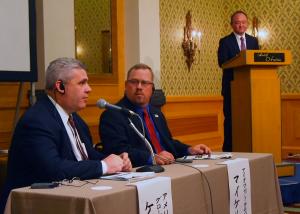Exports are brokered across continents, but customers still appreciate the opportunity to talk face-to-face with their suppliers – particularly U.S. farmers.
Michael Fritch, who farms in central Iowa, traveled this month with U.S. Grains Council (USGC) Senior Director of Global Programs Cary Sifferath to facilitate discussions on crop progress, quality and marketing in two of the largest and most stable markets for U.S. feed grains, Japan and South Korea.
Japan is traditionally a top market for U.S. feed grains, coming in as the second largest buyer of U.S. corn, following Mexico, in 2015/2016. Japan was also the second largest buyer of U.S. barley and the third largest buyer of U.S. sorghum in 2015/2016.
This far in the marketing year (September-April), Japan purchased 8.92 million tons (351 million bushels) of U.S. corn, a 71 percent increase year-over year. The country has bought more U.S. sorghum in the current marketing year (nearly 137,000 tons, or 5.4 million bushels) than overall purchases for the past four marketing years. Japan has also been a strong buyer of U.S. co-products in recent months, purchasing 62 percent more U.S. DDGS compared to last year at this time, more than 275,000 tons.
The Japanese market was built over decades through an open and honest exchange of information on crop quality, emerging technology and supply availability between members of the U.S. agriculture value chain and Japanese buyers and end-users. Missions like the one this month are critical to maintaining this loyalty to U.S. feed grains and co-products.
“Japan is a very important long-term buyer of U.S. corn and other feed grains,” Sifferath said. “We have to assure them of the stability of a long-term supply of U.S. corn and that we are continuing to produce good quality corn to meet the demands of the Japanese feed industry as well as other global markets.”
More than 110 Japanese customers and feed millers attended the crop seminars in Japan, including members of the Japanese Feed Manufacturers Association (JFMA) and JA Zen-Noh, the most influential agricultural cooperative and the largest importer of U.S. distiller’s dried grains with solubes (DDGS).
During these meetings, Sifferath presented on the results of U.S. crop quality. Fritch, as a fifth generation farmer, provided a from-the-farm update on crop progress and conditions as well as an explanation of the latest farming practices and technologies utilized on his farm in central Iowa.
“Our customers appreciate corn farmers like Mr. Fritch coming from thousands of miles away to Japan to present on their farming practices and to talk with customers directly,” said Tommy Hamamoto, USGC director in Japan. “Doing so gives customers trust and credibility in U.S. corn and the Council can show the transparency and openness of the U.S. grain marketing system.”
The pair also traveled to the northern part of Japan, visiting a feed mill and large beef operation that uses imported U.S. corn as well as the port expansion at Kushiro Port, which will allow the intake of Super Post-Panamax vessels.
The pair next took their crop quality information to the third largest market for U.S. corn and DDGS, South Korea.
South Korea has purchased 4.12 million tons (162 million bushels) of U.S. corn thus far in the marketing year (September-April), up significantly year-over-year. South Korean purchases of DDGS are also up 27 percent year-over-year, at more than 677,000 tons. The country is a top market for U.S. ethanol, with more than 27.1 million gallons in purchases this marketing year.
Sifferath and Fritch met with the Korean Feed Association (KFA), which accounts for 70 percent of the nation’s total mixed feed production, as well as Nonghyup Feed Inc., the feed business unit of the National Agricultural Cooperatives Federation, the world’s eighth largest cooperative. The pair also visited the new grain port in Pyeongtaek and Cargill’s newest and largest animal feed mill in their global feed operations, Cargill Agri Purina.
“The seminar held in Seoul was a very timely and beneficial opportunity for the feed grain industry in Korea to get information on the new crop corn and the current supply and demand situation as corn planting has almost been finished,” said Haksoo Kim, USGC director in Korea.
In both countries, the clear message was that U.S. farmers and agribusiness value these steady North Asian markets and are willing to go the distance – literally – to keep buyers and end-users informed.
“We appreciate Japan’s and South Korea’s loyalty as top customers for U.S. feed grains,” Sifferath said. “The U.S. corn industry is committed to ensuring a stable supply of quality grains to their markets and the rest of the world.”
Read more about the Council’s work in Japan here and more about the Council’s work in South Korea here.



